Why is my Polaris Trailboss 7174820 not starting? Fuel valve is off?
- AAmanda BradleyAug 21, 2025
If the fuel valve is turned off on your Polaris Offroad Vehicle, turn the fuel valve on.

Why is my Polaris Trailboss 7174820 not starting? Fuel valve is off?
If the fuel valve is turned off on your Polaris Offroad Vehicle, turn the fuel valve on.
How to properly break in a new belt on Polaris Trailboss 7174820?
Always break in a new belt and/or clutch on your Polaris Offroad Vehicle by avoiding aggressive or high speed operation during the first two full tanks of fuel.
What to do if water gets in the belt housing of my Polaris Trailboss 7174820 Offroad Vehicle?
If your Polaris Offroad Vehicle experiences belt slippage from water or snow ingestion into the PVT system, shift the transmission to neutral. Using the throttle, vary the engine RPM from idle to full throttle. Repeat several times as required. During this procedure, the throttle should not be held at the full position for more than 10 seconds. Clutch seals should be inspected for damage if repeated leaking occurs.
How long should I warm up my Polaris Trailboss 7174820 Offroad Vehicle in cold weather?
Warm the engine of your Polaris Offroad Vehicle for at least 5 minutes if exposed to low ambient temperatures. With the transmission in neutral, advance the throttle to about 1/8 throttle in short bursts, 5 to 7 times. The belt will become more flexible and prevent belt burning.
How to warm up the belt on Polaris Trailboss 7174820?
Always warm up the belt of your Polaris Offroad Vehicle by operating below 30 mph for one mile (5 miles or more when the temperature is below freezing).
What to do if Polaris Offroad Vehicle solenoid connections are loose?
If your Polaris Offroad Vehicle has loose solenoid connections, check all connections and tighten them.
What to do if Polaris Offroad Vehicle battery connections are loose?
If your Polaris Offroad Vehicle has loose battery connections, check all connections and tighten them.
How to fix low battery voltage on Polaris Trailboss 7174820?
If your Polaris Offroad Vehicle has low battery voltage, recharge the battery to 12.8 VDC or higher.
What to do if my Polaris Trailboss 7174820 is out of fuel?
If your Polaris Offroad Vehicle is out of fuel, turn the fuel valve to reserve and refuel.
| Brand | Polaris |
|---|---|
| Model | Trailboss 7174820 |
| Category | Offroad Vehicle |
| Language | English |
Instructions for recording VIN, engine serial, and key numbers.
Comprehensive safety advice for ATV operation, training, and age restrictions.
Dangers and warranty issues related to modifying the ATV.
Explains the purpose and location of various safety decals on the ATV.
Details on helmets, eye protection, gloves, boots, and clothing for rider safety.
How to use the main switch, engine stop, and override switches.
Using the throttle lever and understanding the Electronic Throttle Control system.
Operation of headlights, taillights, and dashboard indicator lights.
Checking brake fluid levels and master cylinder.
How to use the main brake lever and parking brake safely.
Function and operation of the foot pedal auxiliary rear brake.
Details on choke, fuel valve, tank, and filter.
Handling gasoline safely and understanding exhaust fume hazards.
Safe selection of forward, neutral, and reverse gears.
How to use the recoil starter for engine ignition.
Steps for breaking in the engine, drivetrain, clutches, and belt for optimal performance.
A detailed checklist of items to inspect before operating the ATV for safety.
Step-by-step instructions for starting the ATV engine, including choke usage.
Guidelines for distributing and securing cargo on racks for stable operation.
Basic steps for safe driving, including posture, warm-up, and initial maneuvers.
Technique for making smooth turns, including body positioning and speed.
Precautions and techniques for riding on wet trails, loose gravel, or freezing conditions.
Procedures for climbing hills, including weight transfer and speed control.
Techniques and warnings for driving across the side of a hill.
Procedures for descending hills, focusing on weight transfer and braking.
Step-by-step guide for safely turning the ATV around on a hill.
Procedures for crossing water and post-operation checks.
Tips for navigating terrain with logs, rocks, and low branches.
Precautions and techniques for operating the ATV in reverse.
Procedures for parking the ATV on a slope, including safety measures.
Info on noise, crankcase, exhaust, and electromagnetic emission systems.
Explains the periodic maintenance schedule and definitions for severe use.
Guidelines for lubricating various components using recommended lubricants.
Instructions for checking and changing the engine oil, including oil type recommendations.
Procedures for checking and changing transmission oil.
Checks for fluid leaks, lever travel, and brake pad wear.
Procedure to check the vehicle's toe-out alignment.
Instructions for removing side panels and checking the steering assembly.
Info on non-adjustable settings and handlebar adjustment.
How to adjust the carburetor idle speed for optimal performance.
Steps to adjust the throttle cable freeplay at the handlebar.
Information on wheel removal and tire condition checks.
Guidelines on tire size, inflation, wear, and wheel hub tightening.
Procedure for checking and adjusting the rear drive chain slack.
How to inspect, lubricate, and care for the drive chain.
Instructions for removing, cleaning, and reinstalling the air filter and pre-filter.
Replacing headlight bulbs and adjusting the high beam.
Spark plug recommendations, inspection, and replacement procedures.
Steps to take if the ATV becomes immersed in water.
Explanation of PVT system and procedure for drying it after water ingestion.
Procedures for battery care, removal, installation, and charging.
Methods for washing, polishing, cleaning wheels, and preparing for storage.
Procedures for securing and transporting the ATV on a vehicle.
Technical data on weight, fuel, oil, engine model, bore, stroke, and cooling.
Specs for drive system, suspension, brakes, lights, battery, and indicators.
Charts detailing jetting and clutching settings based on altitude and temperature.
Common issues related to the drive belt, clutch engagement, and possible causes.
Troubleshooting for no start, failed starts, and engine knocking.
Solutions for engine backfiring, irregular running, stalling, and misfires.
Troubleshooting for when the engine stops or loses power.
Details of the limited warranty, coverage, exclusions, and registration requirements.
How to get warranty service, including dealer responsibilities and owner rights.
Policies for service outside purchase country and for second-hand vehicles.
Specific warranty coverage for emission control components.
A chart to record all scheduled maintenance and service performed on the vehicle.


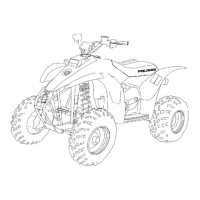
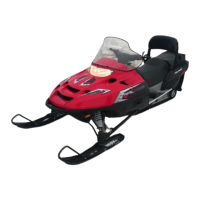
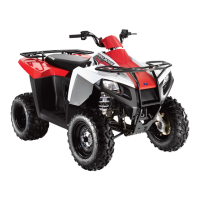

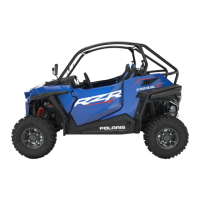

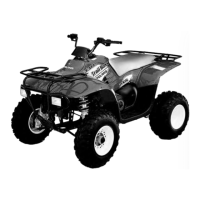
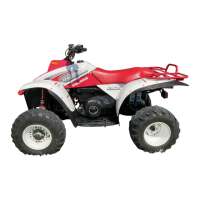


